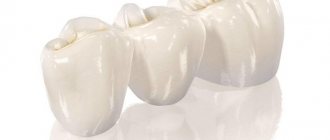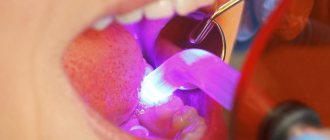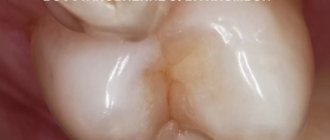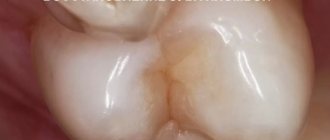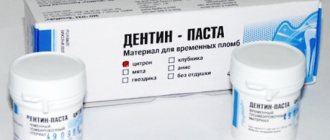Pediatric dentistry can be considered a separate section of modern dental practice, because due to the structural features, the treatment of baby teeth is somewhat different from the treatment of permanent teeth. Unfortunately, many parents are still convinced that baby teeth do not need dental care - after all, they will soon break down and fall out anyway. Therefore, children are not taken to the dentist very often, and if they are taken to the doctor, it is with advanced diseases and multiple problems.
In fact, dental treatment should be carried out at any age, and the sooner you consult a doctor with a problem, the higher the likelihood of getting rid of it quickly and without any complications. If a child has bad baby teeth, this will inevitably affect the health of his permanent ones - this is what parents need to remember when they want to “pity” the baby and not take him to an appointment with the “evil dentist.”
Gum inflammation
The most common inflammatory gum diseases in children are stomatitis and gingivitis. Stomatitis, or, as it is usually called, thrush, is an infectious inflammatory process provoked by fungi of the genus Candida. Treatment is antifungal and anti-inflammatory therapy, always carried out under the supervision and recommendations of a dentist. Self-medication can be dangerous, as some children may have allergic reactions to certain medications or antiseptics.
Gingivitis most often occurs due to plaque on baby teeth and insufficient general hygiene, but the reasons for their development can also be trauma to the gums during teething or other injuries, untreated caries. With this problem, you also need to contact a doctor, who will select the optimal treatment regimen and prevent gingivitis from developing into childhood periodontitis.
Filling for a child - high quality, pain-free and at an affordable price
Most parents are reluctant to visit the dental office with their children. They perceive this as stress for the child, since they clearly remember their own childhood. In their memories, the dentist is a doctor with a stern look, cold hands and an arsenal of instruments for torture. Fortunately, pediatric dentistry looks very different today.
At the Natadent dental clinic, dental fillings for children are performed by qualified doctors, whose professionalism is manifested not only in high-quality treatment, but also in the ability to find an approach to young patients.
The following features of our clinic help us make treatment comfortable for the child:
A children's playroom where the doctor gets to know each other and spends time in a playful way with the baby before the appointment.
- friendly atmosphere in the office, preliminary communication and explanation of all the intricacies of treatment.
- use of modern tools and materials;
- local anesthesia, sedation and general anesthesia (if necessary);
- colored fillings and other playful ways to motivate a child;
- gifts after each reception
- cartoons during treatment
If you want your child to have healthy teeth and not be afraid of the dental office in the future, bring him to the Natadent clinic. Our doctors perform dental fillings for children quickly, efficiently and in a fun way. Thanks to this, the child will not be afraid and will remember that dental treatment is a short, painless and very important procedure.
Caries, pulpitis and periodontitis of primary teeth in children
Milk teeth have thinner enamel and dentin layers than permanent teeth, they have a larger pulp chamber and, therefore, infection spreads faster to the pulp. They are more often susceptible to carious lesions - and not least because of night feeding or the habit of drinking drinks from a bottle at night (mostly sweet or sweetened - tea, juices).
In addition, caries is often provoked by plaque on baby teeth, which forms faster than in adults, and which not all parents are in a hurry to remove. Many people begin brushing their children’s teeth at a more or less conscious age, while a child should be taught hygiene and regularly remove plaque from the moment the first teeth erupt, that is, from about six months of age. Also, the cause of diseases of the dental system can be an insufficient amount of solid food in the baby’s diet, since chewing solid food helps to clean the dental surfaces themselves.
The child's nutritional habits, lack of hygiene, and too thin enamel layer provoke a phenomenon called circular caries of baby teeth - carious lesions spread over the entire tooth surface, as if encircling the crown.
Caries quickly turns into pulpitis - an inflammatory lesion of the dental pulp. Most often, a doctor is consulted precisely at this stage of the infectious process, ignoring the initial stages of damage to dental tissues. Pulpitis, in turn, provokes periodontitis of primary teeth in children - inflammation of the periodontal tissues near the tips of the tooth roots. This condition is usually accompanied by severe pain, severe swelling of the affected area, and often an increase in body temperature.
Stages of dental filling
The first step is to clean the carious cavities with a drill. This procedure is aimed at eliminating areas affected by caries and is carried out with anesthesia. In case of severe damage to the tooth, therapeutic spacers and pins are installed.
The next stage of dental filling is the installation of a filling. In this case, the choice of filling largely depends on the location of the damaged tooth, the general condition of the patient, as well as the durability and aesthetics of the material.
Currently, when filling teeth, materials such as ceramics, photopolymers, glass ionomers, dental cement mixtures, metals, etc. are used. Each of them has its own advantages and disadvantages.
For example, in the past, cement mortars with high strength and durability were most often used. However, their increased characteristics are the reason that the tooth’s own enamel wears off over time and the tooth is completely destroyed.
Currently, when filling teeth, modern ceramic and photopolymer fillings are actively used, which do not destroy tooth enamel, are reliable, durable and resistant to sudden temperature changes in the oral cavity.
After installation, the seal must be carefully sanded. This is a necessary final stage of filling, which will ensure normal, natural closure of the jaws and prevent human discomfort. At the request of the patient, the top of the filling is treated with a special protective varnish. In general, the filling procedure lasts no more than an hour.
Contact the specialists of our clinic and they will install a high-quality, durable filling that will make your teeth strong and your smile irresistible and natural!
Dental treatment for a child aged 2-3 years
Serious problems rarely arise at an early age. By two years, the central and lateral incisors, canines and lower molars have already appeared. By the age of three, the second molars in both rows have erupted. At the age of 2-3 years, caries of baby teeth may already begin, which must be cured in a timely manner. Therefore, we recommend visiting your dentist regularly.
Dental treatment for a 4 year old child
At this age, usually all the baby teeth have already erupted, and they have not yet begun to fall out. It’s too early to talk about the formation of a bite, but you need to keep an eye on your tooth enamel. Dental treatment for children is usually limited to cleaning and removing caries. Cases of pulpitis are rare.
Dental treatment for a child aged 5-6 years
During this period, some children may already lose the central incisors of the upper and lower rows. Normally, this occurs at 6-7 years of age. There is still a high risk of caries in primary teeth. In advanced cases, erosion or fluorosis, pathological abrasion of the dentition, and wedge-shaped defects may develop. To avoid complications, do not forget about preventive visits to the dentist.
At this age, you should definitely visit an orthodontist, even if, in your opinion, the child is doing well.
Treatment of baby teeth
At the initial stages, caries is treated without tissue preparation - remineralization of the enamel, as well as modern Icon technology, which allows filling without drilling, easily cope with carious lesions of the enamel layer. In later stages, when the dentinal layer is affected, as well as in the case of pulpitis and periodontitis, treatment of baby teeth with tissue preparation will be required. You should not be afraid of such procedures - modern methods of anesthesia allow them to be carried out completely painlessly and comfortably for a small patient. In addition, the anesthetics used are harmless, with a minimum concentration of the active substance. And the site of the upcoming injection itself is numbed by applying a special gel or spray (application anesthesia).
Experienced dentists try to carry out treatment quickly so that the child does not have time to get tired and capricious. If a child has bad baby teeth and a large amount of work is required, it is divided into several stages. It also happens that the child does not want to contact the doctor, is too afraid of treatment, or the volume of manipulation is too large and serious - in such a situation, it is possible to carry out therapy under anesthesia or with intravenous sedation (with a preliminary examination).
In case of pulpitis, the root canals are filled with special pastes that dissolve simultaneously with the “milky” root, so there is no chance that the medicinal material will remain in the tooth socket and will prevent the new tooth from growing properly.
Types and compositions of popular fillings for baby teeth
The most popular in pediatric dentistry:
- Chemically cured fillings made of glass ionomer cement. The material contains fluoride ions, which are responsible for the remineralization of tooth enamel and prevent the proliferation of pathogenic bacteria. Positive characteristics include non-toxicity, biocompatibility, low shrinkage, and good fixation on different surfaces. The filling composition performs well when working with chewing teeth. It is often used under a crown for children's prosthetics. There is only one serious drawback: it takes about a day for the filling to dry completely.
- Metal fillings based on silver amalgam. When hardened, the compounds look rather unaesthetic, so they are used when filling distant teeth. Fillings are famous for their durability. Due to their pronounced antibacterial properties, secondary caries does not form underneath them.
- “Light” photopolymer fillings. The light-curing composite is plastic and easy to use - it allows you to recreate the surface of the tooth down to the smallest detail. This is the best material for restoring incisors, but is also suitable for treating other teeth. The polymer hardens quickly under the influence of a special lamp, but is very sensitive to moisture. Protection from saliva is provided by a rubber dam, a special rubber insulator placed around the teeth being restored.
- Colored compomer fillings. The material is a symbiosis of a hybrid composite and glass ionomer cement, which guarantees double advantages and improved properties. It is convenient to control the colored filling based on the degree of wear - changes in the shade indicate the need to visit a doctor.
All fillings, with the exception of colored fillings, are used equally successfully in both pediatric and adult dentistry, which inevitably leads to the question: is it possible to give children adult fillings?
Restoration of baby teeth
If a child’s baby tooth breaks off or if the dental crown is severely damaged by caries, restoration is carried out. However, if for adult patients one of the most important aspects during restoration is aesthetics, then for children functionality is much more important. Therefore, restorative filling materials are always selected taking into account the patient’s age - for children, durability and impeccable aesthetics are not so important, a good marginal fit of the fillings and the preservation of dental tissues are much more important. Filling materials that are too strong can put pressure on dental tissues and contribute to their destruction, and therefore dentists choose materials that will recreate and maintain the integrity of the dental crown until the moment of natural tooth loss.
How the procedure works
Filling baby teeth is similar to filling molar teeth. The main difference is that when temporary teeth are restored, they are filled entirely: to avoid re-damage, healthy fissures are also covered with filling material. To avoid fissure caries of primary molars, dentists recommend fissure sealing as soon as teeth erupt.
Depending on the degree of caries damage and the patient’s age, the dentist chooses a treatment method:
- if the carious cavity is small, manual preparation is allowed;
- treatment of the affected area with chemicals;
- preparation using a drill.
Remember, careful care and timely treatment of temporary teeth is the key to the health of permanent teeth.
Removal of baby teeth in children
Removal of baby teeth in children is carried out only for specific indications or in the case when the tooth is ready to fall out on its own and just needs a little “help”. If there is a choice - to remove or treat, a competent dentist will always advise treatment, since the early loss of baby teeth leads to a number of serious disorders of the dental system, including the appearance of permanent bite defects.
Extraction operations should be carried out exclusively in the dentist’s office - attempts to remove teeth at home can lead to injury to soft tissues, infection of the socket, injury to the rudiment of a permanent dental unit, etc. The doctor will perform the extraction under local anesthesia quickly, competently and completely painlessly.
Caring for fillings on baby teeth
After visiting the doctor, the child must be explained the importance of proper care of the filling. In the first days, you need to be careful about putting stress on the treated tooth. Dentists recommend the following to maintain the condition of teeth after filling:
- Do not give your child hot or cold food in the first few days after treatment, so as not to harm the process of the filling shrinking in the cavity and binding it to the tissues.
- Avoid giving food that is too hard or sticky.
- Conduct regular examinations of the entire oral cavity, including the unit that has been treated, and be attentive to what sensations the child experiences.
- Visit the dentist after 4 months to monitor the condition of the filling and the entire oral cavity.
- Reduce consumption of carbonated and sugary drinks to a minimum. Dilute the juice with water. Introduce more vegetables and high protein foods into your diet.
- Together with the dentist, select a suitable toothpaste and brush for the child, and undergo training in proper cleansing. Instill the habit of brushing your teeth.
- Limit the use of sticky foods, such as chewing gum.
If a baby tooth hurts after filling
, don't worry right away. Pain after treatment with extensive surgery is normal and goes away on its own within one or two days. When filling the roots, the pain may go away after two weeks. If a child has a fever or swelling in the intervention area, these are symptoms that require you to consult a doctor.
Continuing pain may indicate that adequate treatment was not carried out, the technology was violated when placing the filling material, the tooth was opened carelessly, damaging the tissue, or the treatment was not completed (in the case of canal filling). In rare cases, a child may develop an allergy to the filling material.
What to do if baby teeth grow crookedly?
If parents notice that their child’s baby teeth are growing crookedly - for example, there is crowding or improper occlusion - this is a reason for a mandatory consultation with a pediatric orthodontist. It happens that due to anomalies of the facial skeleton (in particular, improper development of the jaws), defects are noticeable even with a primary bite, and with a permanent bite they will persist and worsen.
Therefore, it is recommended to show the child to an orthodontist from the age of three to determine whether there is pathology and find methods for its correction. There are malocclusions that are easily corrected at an early age and extremely difficult to correct in adults.
How to protect baby teeth from caries?
Prevention is the best way to cope with any disease. Therefore, those parents who care about the health of their children should definitely think about caries prevention. How to protect baby teeth from caries? The recommendations of experts in this matter are as follows:
- The correct diet for the mother during pregnancy is with a sufficient amount of foods containing calcium, fluorine and phosphorus: cottage cheese, beef and beef liver, sea fish, nuts, fruits and vegetables, cereal porridges.
- Compliance with hygiene standards: daily brushing from the moment the first teeth appear, first with a cotton or gauze swab with boiled water, then with special baby brushes and pastes. Plaque on baby teeth should be removed promptly and thoroughly.
- A healthy diet for a child: as little fast carbohydrates, carbonated drinks, sweets as possible, more fruits and vegetables, cereals, and dairy products.
- Timely visits to the dentist for preventive examinations (at least once every six months).
It is important that parents develop a conscious attitude towards the health of their children's teeth and oral cavity in general. A timely visit to the dentist in case of any identified problems, as well as for regular medical examinations, will help maintain the health of the child’s dental system – and therefore the digestive system too.
Colored fillings for children
Everyone knows about the need for preventive visits to the dentist, but not only children, but also adults themselves are often afraid to cross the threshold of the clinic, having had negative dental experiences in childhood. But the longer you postpone the visit, the larger the problem and the longer the treatment may be.
First meeting with the dentist
It is recommended to introduce the baby to the doctor as early as possible, explain that the doctor cares about his teeth and is ready to tell him how to care for them. If you bring a child to the dental office for the first time with already advanced caries and acute pain, then such an appointment will definitely not leave a pleasant impression. In the future, dental phobia (fear of treatment at the dentist) and a negative attitude even towards preventive measures may develop. Parents should understand that modern equipment and materials make treatment almost painless, and pleasant little things can distract and even please the child. This approach will be the key to a beautiful and healthy smile, as well as a positive attitude towards visiting the dental clinic.
Why do you need to treat baby teeth?
It is a common belief that baby teeth do not need treatment, since they will fall out sooner or later anyway. But this idea of parents is wrong. And there are several reasons for this:
- milk teeth, like permanent teeth, are designed to perform a chewing function and provide a uniform load: their absence can negatively affect the digestion process, speech development or diction;
- early loss or removal of an affected tooth can adversely affect the bite in the future, which means that orthodontic treatment will be required;
- the roots of baby teeth come into contact with the rudiments of permanent teeth, so diseases of the former can affect the latter.
Only regular preventive measures and timely treatment of diseases will help to avoid these problems. It is necessary to see a doctor urgently if you notice dark or whitish spots on the teeth, bad breath, swelling of the cheek, or if the child himself complains of pain or discomfort.
What are colored fillings
Even if a child is calm about visiting a dental clinic, he is unlikely to enjoy the treatment process itself. In this regard, specialists from different countries are constantly trying to come up with new ways to make the procedure more comfortable and even positive. One of the most successful solutions is the use of colored fillings. Such material can interest a small patient and even improve his mood.
For adults, this idea may seem a little absurd, because we all strive to hide the defect that has appeared as much as possible, and choose a filling that matches the color of our own tooth. Children see this as a game: colorful spots on their teeth seem fun to them and express their individuality and preferences. In addition, the process of choosing a color can distract the child from unpleasant manipulations. And how great it is to then show off to your friends such a “new thing” and the fact that it was not scary at all! The color scheme will also please young fashionistas. There are usually seven bright colors in a dentist's arsenal: orange, blue, pink, yellow, green, silver and gold. If you plan to treat several teeth at once, you can collect a small collection.
Benefits of installing a colored filling
Compomer is used to make colored fillings. It consists of glass ionomer and photopolymer. The first helps saturate the enamel with fluoride and gives the filling high adhesion, the second provides strength to the material.
The use of colored fillings in pediatric dentistry has a number of advantages:
- they are bright and cheerful, creating a positive impression on the child;
- the material from which colored fillings are made ensures quick filling from capsules;
- long service life - up to 3 years.
But still, the main advantage of colored fillings is the positive perception of the child. Children cease to be afraid of the dentist and evaluate the treatment itself as the acquisition of a new piece of jewelry. In addition, they increase interest in the process of dental care, because the child wants to keep his colored fillings for as long as possible.
How does the filling installation process work?
The whole point of filling, both when using regular and colored fillings, comes down to removing damaged tissues and replacing them with artificial ones. In any case, one goal is pursued - to preserve the functionality and aesthetics of a baby tooth for a longer period.
The filling process takes place in several stages:
- The area around the tooth is numbed. To do this, the doctor uses a suitable anesthetic with a precisely calculated dosage. If a child is afraid to give an injection right away, he is offered to anoint his gums with “fruit chill”.
- Then the dental cavity is thoroughly cleaned of damaged tissue. For these purposes, a drill, laser or sandblasting tools are used.
- During the treatment process, it is important to check the condition of the pulp. If it is not damaged, then disinfection is carried out. If the pulp is inflamed, a decision is made to remove it.
- After the doctor makes sure that the caries has been removed, the tooth cavity is cleaned of bacteria. At this stage, a special gasket is also installed that will protect the nerve from the applied filling material.
- Finally, the filling itself is carried out with the material of the selected color. It is applied in even layers. To make the filling hard, it is exposed to a special light. After this, polishing and grinding are carried out.
Caring for fillings on baby teeth
After installing a colored filling on a baby tooth, you need to follow some of the doctor’s recommendations. This will help the material harden properly and serve its little owner longer. It is also important to tell your child what not to do so as not to damage the filling.
General recommendations for caring for fillings include the following:
- In the first days after filling, you should avoid eating cold or hot food or drinks. It can negatively affect the binding of dental tissues and filling material, i.e., worsen adhesion;
- in the future, it is recommended to minimize the consumption of hard and sticky foods that can damage the filling itself and the tooth;
- In the first time after treatment, you need to carefully monitor the condition of the child’s oral cavity. If unpleasant symptoms appear (pain, deformation of the filling, swelling of the gums, etc.), you should immediately consult a specialist;
- The placement of your first filling should be an important signal that you need to pay more attention to your oral hygiene. It is important to teach your child how to brush their teeth correctly, tell them about the need to rinse their mouth after eating, and you should also consult with your dentist about choosing the right toothpaste;
- Although the filling material is highly durable, it is still susceptible to the negative effects produced by sour and sweet foods. Therefore, it is recommended to reduce their amount in the child’s diet, but vegetables and protein foods should be added to the menu;
- After fillings are installed, it is recommended to visit a pediatric dentist approximately once every 3 months to monitor the condition of the filled teeth and promptly identify possible defects.
Our offer
Do you need dental treatment for your child? Do you want the process not to cause him fear and unpleasant impressions? Sign up for the Martinka clinic. We employ professional dentists who know how to approach a child. The cost of installing colored fillings for children starts from 1,650 rubles. If you would like to learn more about our services and make an appointment, please call the phone number listed above.

